November’s winding down. Thanksgiving feasts extended to the resaca this year, as flock-friends and their relatives arrived to partake of the water’s bounty.
No less than 50 White Pelicans have been feasting. Although fun to watch and photograph, they can deplete the fish stores in a hurry. They really need to move along to a larger body of water.
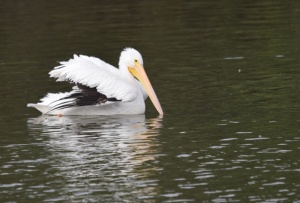
Watching the pelicans puts me in mind of one of my favorite games — playing Collective Bird Nouns. It’s mostly that the pelicans seem to lend themselves to certain descriptive words:
A flight, a zig-zag of pelicans
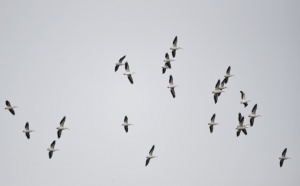
A gaggle, a clutter, a pod, a conglomeration of pelicans.
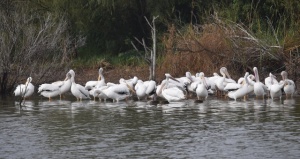
A raft, a chorus line, a barge of pelicans.

What pelicans don’t do, line themselves up neatly in a regiment or precision of pelicans.
Moving on, seven Black-crowned Night Herons sat staggered in a tree across the resaca, just visible enough in the binoculars to count. Later, one Black-crowned night-heron sat on the bench at our fishing dock.
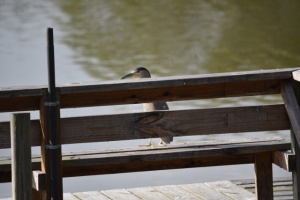
The Osprey is back again on his/her mesquite perch. Not quite used to our presence yet this year, it also spends time on the distant shore where there are a number of tall snags for watching for fish. It comes back to the mesquite branch with its catch.
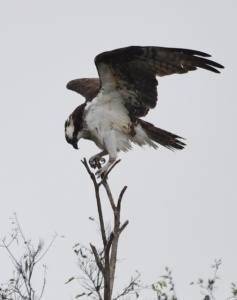
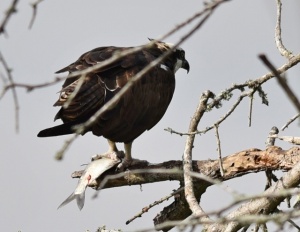
The Osprey branch has been busy this past week. I don’t think the other birds realize it’s not up for grabs. We’ll see, though; it’s early days yet.
The first surprise was, after eight years of blurry photos of any of the resident Kingfishers along the retaining wall, the Belted Kingfisher finally was close enough for a great shot — perched on the Osprey branch!
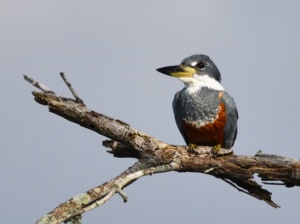
She perched long enough for me to race back indoors and fetch my camera.
The next day, another surprise.
About every five years, I get a shot of this bird. It’s in my birding book, but I never remember it because the picture doesn’t show the bird wearing these colors. It’s a Little Blue Heron — thank you Super Bird Identifier Extraordinaire Norma Friedrich, president of Harlingen’s Arroyo Colorado Audubon Society (ACAS).
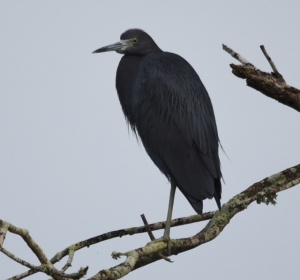
It’s a beautiful bird. At first, the feathers look to be a deep navy-blue, then the bird appears to be totally black. A book description calls it slate-colored with a purplish maroon head and neck. Perhaps, in different lighting – maybe . . . .
According to my birding book, the Little Blue Heron is about two feet tall with a wing-span of 40 to 41 inches. It’s a permanent resident in our part of the Valley and along the Texas and Gulf coast. “It likes fresh water but can be found in brackish water and salt marshes. Feeds on a variety of small vertebrates, crustaceans and large insects. It will roost in trees and shrubs at night.” If it sticks around our resaca, it stays hidden from me.
I do recall photographing one on the old dock supports during last April’s bioblitz. Again, Norma IDd it for me. That time, the photo was of a juvenile. It was doing exactly what my birding book described: “. . . molting into adult plumage in its first spring, gradually displaying a calico appearance as it transitioned from white to slate gray.” One leg was gray, while the other was still yellow-greenish.
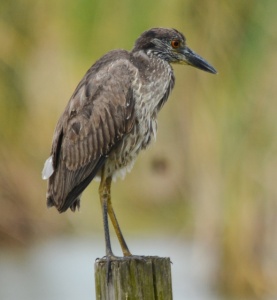
Back to the busy Osprey branch. The branch is some 100 feet from one of the garage bay doors. The mesquite tree is on raised ground as are the driveway, house/garage and other buildings. The tree towers over the lower grounds that skirt the resaca. The over-hanging branch is close enough to the water to provide a primo lookout for sharp-sighted birds and an excellent distance for me to steady my camera and 300 mm lens on the back of my husband’s car in the garage and photograph anything sitting on the tree limb, e.g. Grackles and Great Kiskadees. Our Eastern Phoebe and Couch’s Kingbird briefly alight on the limb, too.
This year is different, too, in that not only are more birds using the Osprey Branch, and the distant-shore birds are apparently getting used to us living here. This year they are checking out the near shore retaining wall and dock.
Scrappy, yellow-footed Snowy Egrets are fishing from both shores of the resaca.
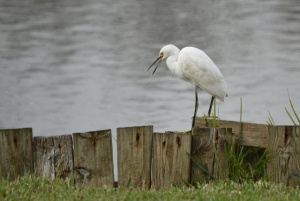
More than one Neotropic Cormorant has been photographed carrying a twig in its bill. Both sexes build the nests, but it seems a bit early for nest building. Internet research says they only breed once, yearly, in the summer. So another resaca mystery.
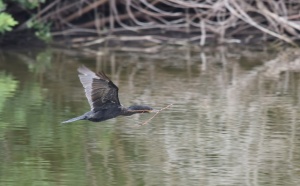
We have about 17 resident Neotropic Cormorants. They, too, used the near-side retaining wall to sun, dry their wings and watch for fish this summer, scattering only when I’d get close with the lawn mower.
An Anhinga dries its wings on a snag on the distant shore where November’s cold snap provided some fall color to the peninsula’s vegetation.
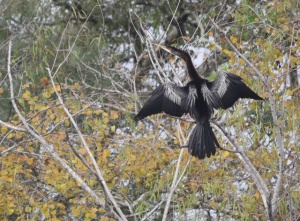
Now that the nutria have nearly completely cleared the horse-shoe resaca of invasive cattails, there’s more shoreline, more snags visible and little cozy inlets for fish/waterbirds to congregate.
I spied a Tricolored Heron the other day in an inlet that last year was inundated with cattails.
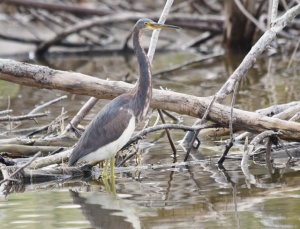
As I was finishing up this missive, a flash of pink caught my eye. Hoisting my camera with long lens onto my desk, I snapped three Roseate Spoonbill scouts in the distance. They didn’t stay long. Perhaps they’ve gone to collect the rest of the flock/regiment/regatta of Roseates!
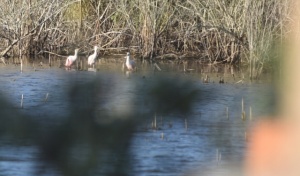
Here’s my Thanksgiving Week Bird List
Belted Kingfisher
White Ibis
50 White Pelicans
Great Blue Heron
Tri-color Heron
Little Blue Heron
7 Black-crowned Night-herons
Cattle Egrets
Snowy Egrets
Great White Egrets
Cormorants
Anhinga
Osprey
Hawk
Blue-winged Teal
Scaup
Grebes
Other ducks
Black and White Warbler
Kingfishers
Great Kiskadee
Phoebe
Mockingbirds
Woodpeckers
Grackles
3 Roseate Spoonbills